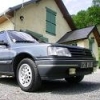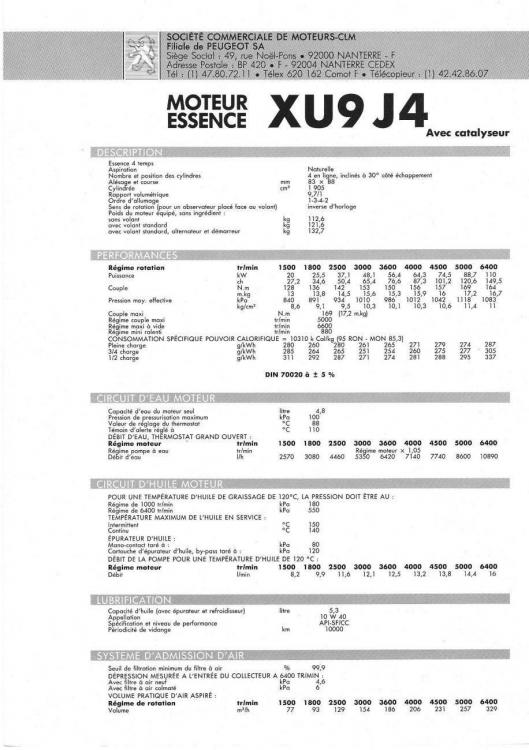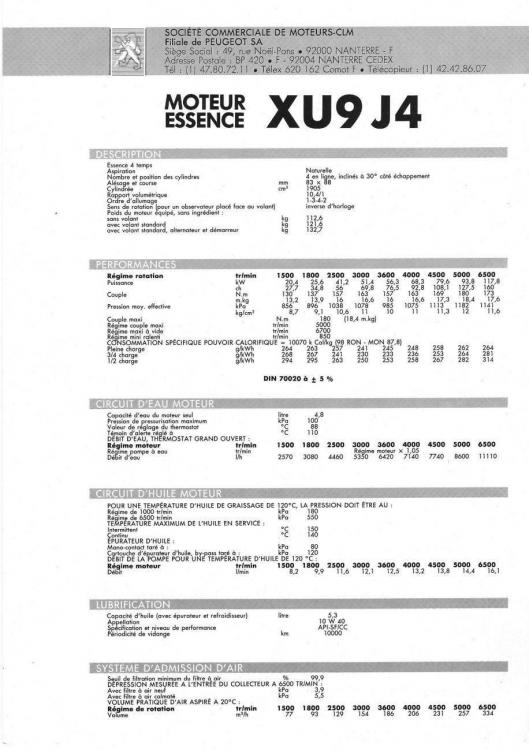-
Posts
647 -
Joined
-
Last visited
Content Type
Profiles
Forums
Gallery
Events
Collections
Everything posted by SRDT
-
Not anymore but yes for a time you failed the inspection if the car had no VIN stamped, stamping one yoursef is obviously illegal but it was the only workaround. That was dumb but they "fixed" their mistake in an even dumber way ; they should have exempted the cars manufactured before 1981 right? Instead they exempted cars older than 30 years... so each year there is a new batch of cars that, for no good reason, can pass the inspection with no VIN stamped.
-
Until 1981 having a VIN stamped wasn't strictly mandatory in France but Peugeot should have been doing it on the 504.
-
They are probably overly balanced and matched because of poor accuracy in manufacturing at the time.
-

Joe's '91 405 Mi16 (and '90 SW and '92 Mi16)...
SRDT replied to 91MR2's topic in Member build threads
In France if you want leather care products for cheap you can check the horse riding gear at a sporting goods retailer. It may not be the cheaper in your contry but in France it is often the case. -

Hello from a new 59k 505S Turbodiesel owner! Fuse box/electrical Q's...
SRDT replied to todds's topic in Technical Discussion
How do you say (electrical) ground in French? Masse. I don't know if they did it in 81 but later M, P, H and C were used to help locate connectors and components on the car : Moteur = Engine compartment Planche de bord = Dashboard Habitacle = Passenger compartment Coffre = Trunk On my 309 P532 is the switch for the rear window defogger and C945 is the rear heating element. -

Joe's '91 405 Mi16 (and '90 SW and '92 Mi16)...
SRDT replied to 91MR2's topic in Member build threads
The Mi16x4 has the same rear Torsen than a 505 plus a central viscous coupling unit, it should spin all 4 tires or none of them. If you want a winter 405 in the US find another US model and put a Quaife or Val-Racing LSD on it. -
TRX tires are just too expensive and you can find 15" rims with the exact same design... Maybe, if there is enough material, they could be machined to bolt a BBS outher lips and convert them to 16" but other than that I can't see any reason to use them on a 505 or 604.
-

Joe's '91 405 Mi16 (and '90 SW and '92 Mi16)...
SRDT replied to 91MR2's topic in Member build threads
If it's racing pedigrée you want there is even more: the 206 WRC won the WRC championship in 2000, 2001 and 2002. There was quite a bit of freedom to choose the base engine from the rallye car, enough in fact to ditch the 2.0 EW10J4 from the road car and use the XU9J4 instead. The Lotus engine won in 81 and the Toyota engine in 93,94 and 99. -

Joe's '91 405 Mi16 (and '90 SW and '92 Mi16)...
SRDT replied to 91MR2's topic in Member build threads
It's true that at the time it wasn't your average engine: Two oil sprays for each piston, full floating piston pins, (forged) rods located by the pistons, 8 counterweight crank, harmonic damper pulley, waffle pattern cylinder liners, extra ribbed (aluminum) block, bottom end strenghtening plate, magnesium valve cover on top of a 16v head inspired by the 205 Turbo 16 evo. Even today not all of this is common practice. -

Joe's '91 405 Mi16 (and '90 SW and '92 Mi16)...
SRDT replied to 91MR2's topic in Member build threads
Same here, my daily driver is a 309 turbo diesel from 1990 and it can only be insured for a bit much than the bare minimum. My 309 GTI16 from 1991 is insured as a classic car but I can't use it to go to work and I also need to have a "normal" car insured wich in my case is 1 year older! -

Joe's '91 405 Mi16 (and '90 SW and '92 Mi16)...
SRDT replied to 91MR2's topic in Member build threads
In France the super low first offer for old cars is a common trick, when it works they save money and time as the car is scrapped and the case quickly closed (plus you probably insure a newer car that is more expensive). Only if you're clearly unwilling to settle for so little will they transfer your case to "someone who know old cars" and at this point you can expect to get most of the money that is rightfully yours. Having the car insured with regular appraisal or agreed value is a good way to avoid all this drama. -

1982 Lada Niva with a Peugeot diesel engine swap
SRDT replied to Goce's topic in Member build threads
I see, well it is very close to the XUD9A with the crank, rods and camshaft being the same but the head has the injectors and glow plugs reversed like the TUD5: I don't know if it's better or worse performance-wise (it must be better for emissions) but anyway this head isn't built for a turbo engine so it's better to keep the XUD9TE one. As for the head gasket the XUD9TE metal one should be good, the XUD11 one won't line up on one oil descent anyway. -

1982 Lada Niva with a Peugeot diesel engine swap
SRDT replied to Goce's topic in Member build threads
1769cc, it's small for a 1.8 and not really usefull for you. I think the cheaper valve is perfectly up to the job, it's when you buy spare parts that they are ripping you off. -

1982 Lada Niva with a Peugeot diesel engine swap
SRDT replied to Goce's topic in Member build threads
If the cast crank is a XU9J4 one the counterweights should clear the oil squirter bars, also it's probably not exactly the same material than the old XUD crank but I'm not 100% sure. It looks like there are only two cam profiles: XUD7TE-XUD9SD and all the others but it is in fact wrong. Peugeot tweaked the N/A-XUD9TE profile and timing more than once but each time the new cam was deemed close enough. I also had a better look at the valves and the post 07/92 exhaust ones are not really the same between turbo and N/A. Peugeot sold the same spare part but used cheaper valves on the N/A engine assembly line. The turbo valves have a (Y) identifier near the top and the N/A have a (Z). The old valves have a Ø4mm hole on the head and the new ones a Ø12mm hole so they are easy to spot. -

Joe's '91 405 Mi16 (and '90 SW and '92 Mi16)...
SRDT replied to 91MR2's topic in Member build threads
Now that I think about it maybe it's not the seal itself that's bad. On a BE3 gearbox you don't push them all the way, they must protrude by 1.5mm on the right side and 1mm on the left. -

Joe's '91 405 Mi16 (and '90 SW and '92 Mi16)...
SRDT replied to 91MR2's topic in Member build threads
If you can find a bigger heat exchanger that's the easiest way, but then again 240°F is lower than 140°C (284°F) so it's still a safe temp. -
A rectangular throttle plate, that's pretty unusual. It's probably to have a more linear relationship between airflow and throttle angle.
-

1982 Lada Niva with a Peugeot diesel engine swap
SRDT replied to Goce's topic in Member build threads
I can't see if your special crank is forged, with 88 stroke there are two factory cast iron 8 counterweight cranks: the early XUD and the XU9J4. There is also the EW10 but the crankpins are smaller. -

1982 Lada Niva with a Peugeot diesel engine swap
SRDT replied to Goce's topic in Member build threads
8 conterweight forged crank? I think they all have 4 except the one from the DW12. The XUD11 has bigger piston pins than the XUD9 and the rods big end is wider so it's not easy to mix and match. -
Pretty nice indeed.
-

Joe's '91 405 Mi16 (and '90 SW and '92 Mi16)...
SRDT replied to 91MR2's topic in Member build threads
For me a temp over 230°F isn't a problem, the tiny dot before 300°F should be 140°C so as long as you don't go beyond that the engine can run all day with no damage ; and that's with the oil they had 30 years ago. -
It's a 3 bearings block design that evolved into a 5 bearings one, the 2nd and 4th are just here to take a bit more load.
-

Joe's '91 405 Mi16 (and '90 SW and '92 Mi16)...
SRDT replied to 91MR2's topic in Member build threads
The BX instrument cluster had oil pressure and even oil level before starting the engine, because of that every engine had the sensors no matter the car. -

Joe's '91 405 Mi16 (and '90 SW and '92 Mi16)...
SRDT replied to 91MR2's topic in Member build threads
Speaking of gauges the 405 cluster lacks the oil pressure, there is one on the 309 and on this car you better look at it if you're driving it hard. -

Joe's '91 405 Mi16 (and '90 SW and '92 Mi16)...
SRDT replied to 91MR2's topic in Member build threads
My car isn't a 405, I have the same water/oil heat exchanger but the coolant system isn't the same and mine looks like it was moded to run a bit cooler. As for max oil temp according to Peugeot at the time it should be 140°C if continuous and 150°C for short peaks. Pressure and flow values are indicated for a 10W40 oil at 120°C.



